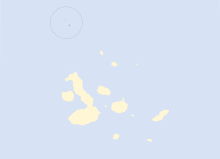Vampire ground finch
| Vampire ground finch | |
|---|---|

| |
| Scientific classification | |
| Domain: | Eukaryota |
| Kingdom: | Animalia |
| Phylum: | Chordata |
| Class: | Aves |
| Order: | Passeriformes |
| Family: | Thraupidae |
| Genus: | Geospiza |
| Species: | G. septentrionalis
|
| Binomial name | |
| Geospiza septentrionalis Rothschild & Hartert, 1899
| |

| |
| Synonyms | |
|
Geospiza difficilis septentrionalis | |
The vampire ground finch (Geospiza septentrionalis) is a small bird native to the Galápagos Islands. It was considered a very distinct subspecies of the sharp-beaked ground finch (Geospiza difficilis) endemic to Wolf and Darwin Islands.[2][3] The International Ornithologists' Union has split the species supported by strong genetic evidence that they are not closely related, and divergences in morphology and song.[4]
Description
The vampire finch is sexually dimorphic as typical for its genus, with the males being primarily black and the females grey with brown streaks. It has a lilting song on Wolf, a buzzing song on Darwin, and whistling calls on both islands; only on Wolf, a drawn-out, buzzing call is also uttered.[2]
Ecology
This bird is most famous for its unusual diet. When alternative sources are scarce, the vampire finch occasionally feeds by
Vampire ground finches drink more blood during dry seasons when seeds and other prey are scarce, resuming omnivorous predation when the rainy season begins. There were also significant variations in the intestinal microbial community structure.[8] There was a clear separation between vampire ground finches and other finches. Vampire ground finch birds have intestinal microbial communities rich in peptostreptococcacea. Similarly, vampire bats also possess peptostreptococcacea in their gut flora.[8]
More conventionally for birds, but still unusual among Geospiza, they also take
Conservation
The vampire finch is classified as
References
- ^ . Retrieved 16 May 2024.
- ^
- ^ Rothschild, W. and E. Hartert. (1899). A Review of the Ornithology of the Galapagos Islands. With Notes on the Webster-Harris Expedition. Novitates Zoologicae Vol. VI, No. 2, pp. 85-205, 2 plates.
- S2CID 205123574.
- ^ doi:10.2307/2408396(HTML abstract and first page image)
- ^ PMID 30231937.
- ISBN 978-0-8133-7979-1.
- ^ PMID 31154984.
External links
- "Vampire Finch". Central Pets. Archived from the original on February 10, 2006. Retrieved Dec 19, 2006.

